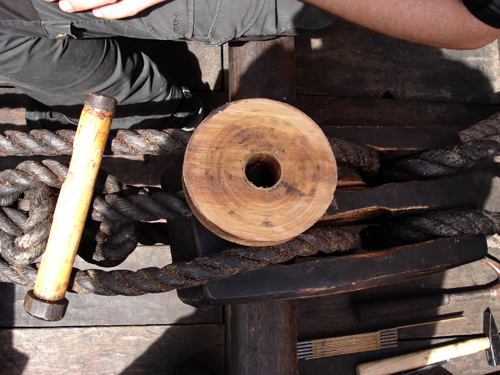Today we inspected both blocks in the halyard tackle to see if the wheels and axles are worn.
The halyard is the part of the ropes used to make sail (raise the sail). The halyard rope is tied around the yard and goes from there through the hole for the halyard at the top of the mast and then down to the halyard tackle. The halyard tackle is made up of two tackle blocks, each with two wheels through which the halyard runner passes. One of these blocks is at the end of the halyard and the other is tied down to the ship all the way aft, just ahead of the navigation lockers. The two two-wheeled blocks together form a four-groove block, the halyard tackle.
It takes ten of the crew to make sail. They sit in pairs on each thwart, facing aft and they pull the halyard runner forwards with their arm, back and thigh muscles. At the same time, two people lock the halyard runner around a clamp on the mast fish.
When the sail is lying on its yard gallows, along the length of the ship, it is raised about halfway up the mast. Here it is peaked about, i.e. the one yard-arm (the end of the yard) is pulled downwards so the yard is vertical along the mast. The yard is then moved ahead of the shrouds, after which it and the sail are released and now hang across the ship; they can now be raised right to the top of the mast.
The sail unfolds as the yard moves up to the halyard hole in the mast top. Four clue lines and two gordings do this. They are located around the sail, run up around the yard and down to the people around the mast. By pulling on the clue lines and the gordings, they can pull the sail up to or down from the yard (see the link to the drawing of the rigging below the paragraph on ‘A longship crew’ elsewhere in this log).
Raising the sail is relatively heavy work. Even with this four-groove block, which reduces the power needed to a quarter, making sail is heavy work. The halyard must be manned when reefing in and out, and in an emergency situation the sail must be run down quickly, so the crew must always be ‘ready at the halyard’.
We know the Vikings knew about pulleys from an archaeological find at Hedeby. Half a pulley block with a wheel diameter of 140 mm was found here. We are unable to determine whether this original pulley had one wheel or two. But when we reconstructed the Sea Stallion, we estimated that if we were to have any chance of making sail it had to be one block with two wheels, put together to make a tackle. Our block is made with the same dimensions as the original pulley from Hedeby.
As mentioned, these blocks are under great pressure when making sail and they therefore also wear. To assess this wear it is necessary to take the blocks apart and take the wheels and axle out. The greatest wear is clearly on the lower block; here, the axle (diameter of 32 mm) is worn 2-3 mm where the wheel runs. The wheels have become a bit oval, perhaps because they are made of a straight piece of wood, where the end of the wood is stronger than the wood that runs along the veins. The pulley house and the wheels are made of birch, which is a type of wood that is very resistant to wear. Birch has greater tensile and compressive strength than oak, for example. The axle is made of hornbeam, which is an even stronger wood type than the two mentioned above.
The wear on the wheel and axle has resulted from the voyage Roskilde – Dublin – Lowestoft. So we put everything back together again, quite confident that it will hold all the way back to Roskilde.
